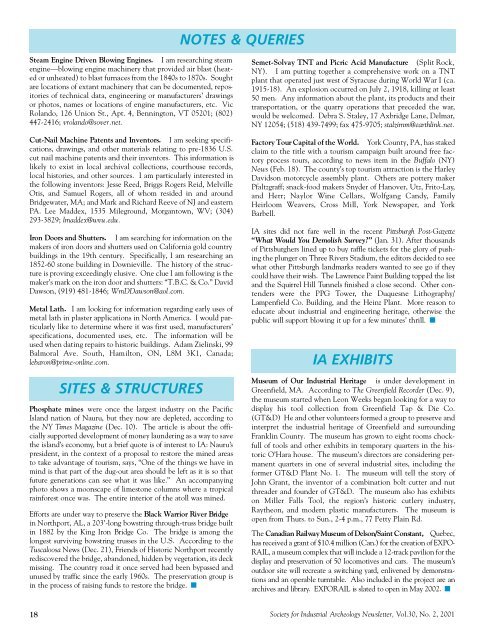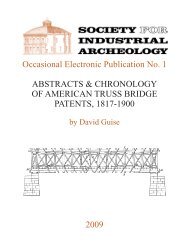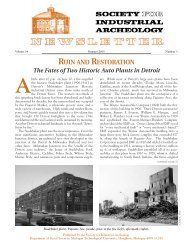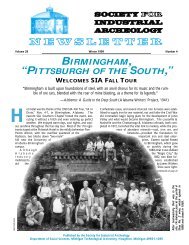RUHR, GERMANY - Society for Industrial Archeology
RUHR, GERMANY - Society for Industrial Archeology
RUHR, GERMANY - Society for Industrial Archeology
You also want an ePaper? Increase the reach of your titles
YUMPU automatically turns print PDFs into web optimized ePapers that Google loves.
Steam Engine Driven Blowing Engines. I am researching steam<br />
engine—blowing engine machinery that provided air blast (heated<br />
or unheated) to blast furnaces from the 1840s to 1870s. Sought<br />
are locations of extant machinery that can be documented, repositories<br />
of technical data, engineering or manufacturers’ drawings<br />
or photos, names or locations of engine manufacturers, etc. Vic<br />
Rolando, 126 Union St., Apt. 4, Bennington, VT 05201; (802)<br />
447-2416; vrolando@sover.net.<br />
Cut-Nail Machine Patents and Inventors. I am seeking specifications,<br />
drawings, and other materials relating to pre-1836 U.S.<br />
cut nail machine patents and their inventors. This in<strong>for</strong>mation is<br />
likely to exist in local archival collections, courthouse records,<br />
local histories, and other sources. I am particularly interested in<br />
the following inventors: Jesse Reed, Briggs Rogers Reid, Melville<br />
Otis, and Samuel Rogers, all of whom resided in and around<br />
Bridgewater, MA; and Mark and Richard Reeve of NJ and eastern<br />
PA. Lee Maddex, 1535 Mileground, Morgantown, WV; (304)<br />
293-3829; lmaddex@wvu.edu.<br />
Iron Doors and Shutters. I am searching <strong>for</strong> in<strong>for</strong>mation on the<br />
makers of iron doors and shutters used on Cali<strong>for</strong>nia gold country<br />
buildings in the 19th century. Specifically, I am researching an<br />
1852-60 stone building in Downieville. The history of the structure<br />
is proving exceedingly elusive. One clue I am following is the<br />
maker’s mark on the iron door and shutters: “T.B.C. & Co.” David<br />
Dawson, (919) 481-1846; WmDDawson@aol.com.<br />
Metal Lath. I am looking <strong>for</strong> in<strong>for</strong>mation regarding early uses of<br />
metal lath in plaster applications in North America. I would particularly<br />
like to determine where it was first used, manufacturers’<br />
specifications, documented uses, etc. The in<strong>for</strong>mation will be<br />
used when dating repairs to historic buildings. Adam Zielinski, 99<br />
Balmoral Ave. South, Hamilton, ON, L8M 3K1, Canada;<br />
lebaron@prime-online.com.<br />
SITES & STRUCTURES<br />
Phosphate mines were once the largest industry on the Pacific<br />
Island nation of Nauru, but they now are depleted, according to<br />
the NY Times Magazine (Dec. 10). The article is about the officially<br />
supported development of money laundering as a way to save<br />
the island’s economy, but a brief quote is of interest to IA: Nauru’s<br />
president, in the context of a proposal to restore the mined areas<br />
to take advantage of tourism, says, “One of the things we have in<br />
mind is that part of the dug-out area should be left as it is so that<br />
future generations can see what it was like.” An accompanying<br />
photo shows a moonscape of limestone columns where a tropical<br />
rain<strong>for</strong>est once was. The entire interior of the atoll was mined.<br />
Ef<strong>for</strong>ts are under way to preserve the Black Warrior River Bridge<br />
in Northport, AL, a 203’-long bowstring through-truss bridge built<br />
in 1882 by the King Iron Bridge Co. The bridge is among the<br />
longest surviving bowstring trusses in the U.S. According to the<br />
Tu s c a l o o s a News (Dec. 21), Friends of Historic Northport recently<br />
rediscovered the bridge, abandoned, hidden by vegetation, its deck<br />
missing. The country road it once served had been bypassed and<br />
unused by traffic since the early 1960s. The preservation group is<br />
in the process of raising funds to restore the bridge. ■<br />
NOTES & QUERIES<br />
Semet-Solvay TNT and Picric Acid Manufacture (Split Rock,<br />
NY). I am putting together a comprehensive work on a TNT<br />
plant that operated just west of Syracuse during World War I (ca.<br />
1915-18). An explosion occurred on July 2, 1918, killing at least<br />
50 men. Any in<strong>for</strong>mation about the plant, its products and their<br />
transportation, or the quarry operations that preceded the war,<br />
would be welcomed. Debra S. Staley, 17 Axbridge Lane, Delmar,<br />
NY 12054; (518) 439-7499; fax 475-9705; stalzimm@earthlink.net.<br />
Factory Tour Capital of the World. York County, PA, has staked<br />
claim to the title with a tourism campaign built around free factory<br />
process tours, according to news item in the Buffalo (NY)<br />
News (Feb. 18). The county’s top tourism attraction is the Harley<br />
Davidson motorcycle assembly plant. Others are pottery maker<br />
Pfaltzgraff; snack-food makers Snyder of Hanover, Utz, Frito-Lay,<br />
and Herr; Naylor Wine Cellars, Wolfgang Candy, Family<br />
Heirloom Weavers, Cross Mill, York Newspaper, and Yo r k<br />
Barbell.<br />
IA sites did not fare well in the recent Pittsburgh Post-Gazette<br />
“What Would You Demolish Survey?” (Jan. 31). After thousands<br />
of Pittsburghers lined up to buy raffle tickets <strong>for</strong> the glory of pushing<br />
the plunger on Three Rivers Stadium, the editors decided to see<br />
what other Pittsburgh landmarks readers wanted to see go if they<br />
could have their wish. The Lawrence Paint Building topped the list<br />
and the Squirrel Hill Tunnels finished a close second. Other contenders<br />
were the PPG To w e r, the Duquesne Lithography/<br />
Lampenfield Co. Building, and the Heinz Plant. More reason to<br />
educate about industrial and engineering heritage, otherwise the<br />
public will support blowing it up <strong>for</strong> a few minutes’ thrill. ■<br />
IA EXHIBITS<br />
Museum of Our <strong>Industrial</strong> Heritage is under development in<br />
Greenfield, MA. According to The Greenfield Recorder (Dec. 9),<br />
the museum started when Leon Weeks began looking <strong>for</strong> a way to<br />
display his tool collection from Greenfield Tap & Die Co.<br />
(GT&D) He and other volunteers <strong>for</strong>med a group to preserve and<br />
interpret the industrial heritage of Greenfield and surrounding<br />
Franklin County. The museum has grown to eight rooms chockfull<br />
of tools and other exhibits in temporary quarters in the historic<br />
O’Hara house. The museum’s directors are considering permanent<br />
quarters in one of several industrial sites, including the<br />
<strong>for</strong>mer GT&D Plant No. 1. The museum will tell the story of<br />
John Grant, the inventor of a combination bolt cutter and nut<br />
threader and founder of GT&D. The museum also has exhibits<br />
on Miller Falls Tool, the region’s historic cutlery industry,<br />
Raytheon, and modern plastic manufacturers. The museum is<br />
open from Thurs. to Sun., 2-4 p.m., 77 Petty Plain Rd.<br />
T h eCanadian Railway Museum of Delson/Saint Constant, Q u e b e c ,<br />
has received a grant of $10.4 million (Can.) <strong>for</strong> the creation of EXPO-<br />
RAIL, a museum complex that will include a 12-track pavilion <strong>for</strong> the<br />
display and preservation of 50 locomotives and cars. The museum’s<br />
outdoor site will recreate a switching yard, enlivened by demonstrations<br />
and an operable turntable. Also included in the project are an<br />
archives and library. EXPORAIL is slated to open in May 2002. ■<br />
18 <strong>Society</strong> <strong>for</strong> <strong>Industrial</strong> <strong>Archeology</strong> Newsletter, Vol.30, No. 2, 2001






